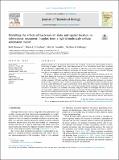Files in this item
Modelling the effects of bacterial cell state and spatial location on tuberculosis treatment : insights from a hybrid multiscale cellular automaton model
Item metadata
| dc.contributor.author | Bowness, Ruth | |
| dc.contributor.author | Chaplain, Mark A.J. | |
| dc.contributor.author | Powathil, Gibin G. | |
| dc.contributor.author | Gillespie, Stephen H. | |
| dc.date.accessioned | 2018-03-21T11:30:05Z | |
| dc.date.available | 2018-03-21T11:30:05Z | |
| dc.date.issued | 2018-06-07 | |
| dc.identifier.citation | Bowness , R , Chaplain , M A J , Powathil , G G & Gillespie , S H 2018 , ' Modelling the effects of bacterial cell state and spatial location on tuberculosis treatment : insights from a hybrid multiscale cellular automaton model ' , Journal of Theoretical Biology , vol. 446 , pp. 87-100 . https://doi.org/10.1016/j.jtbi.2018.03.006 | en |
| dc.identifier.issn | 0022-5193 | |
| dc.identifier.other | PURE: 252493272 | |
| dc.identifier.other | PURE UUID: 9761399e-957c-4ab7-a262-eb5e946be073 | |
| dc.identifier.other | RIS: urn:7131F6CE6432A3DCCB70FB67784A50E5 | |
| dc.identifier.other | Scopus: 85043488654 | |
| dc.identifier.other | ORCID: /0000-0001-6537-7712/work/42504525 | |
| dc.identifier.other | ORCID: /0000-0001-5727-2160/work/55378909 | |
| dc.identifier.other | ORCID: /0000-0002-4090-5168/work/59698739 | |
| dc.identifier.other | WOS: 000430995800008 | |
| dc.identifier.uri | https://hdl.handle.net/10023/12983 | |
| dc.description | This work was supported by the Medical Research Council [grant number MR/P014704/1] and the PreDiCT-TB consortium (IMI Joint undertaking grant agreement number 115337, resources of which are composed of financial contribution from the European Union’s Seventh Framework Programme (FP7/2007-2013) and EFPIA companies’ in kind contribution. | en |
| dc.description.abstract | If improvements are to be made in tuberculosis (TB) treatment, an increased understanding of disease in the lung is needed. Studies have shown that bacteria in a less metabolically active state, associated with the presence of lipid bodies, are less susceptible to antibiotics, and recent results have highlighted the disparity in concentration of different compounds into lesions. Treatment success therefore depends critically on the responses of the individual bacteria that constitute the infection. We propose a hybrid, individual-based approach that analyses spatio-temporal dynamics at the cellular level, linking the behaviour of individual bacteria and host cells with the macroscopic behaviour of the microenvironment. The individual elements (bacteria, macrophages and T cells) are modelled using cellular automaton (CA) rules, and the evolution of oxygen, drugs and chemokine dynamics are incorporated in order to study the effects of the microenvironment in the pathological lesion. We allow bacteria to switch states depending on oxygen concentration, which affects how they respond to treatment. This is the first multiscale model of its type to consider both oxygen-driven phenotypic switching of the Mycobacterium tuberculosis and antibiotic treatment. Using this model, we investigate the role of bacterial cell state and of initial bacterial location on treatment outcome. We demonstrate that when bacteria are located further away from blood vessels, less favourable outcomes are more likely, i.e. longer time before infection is contained/cleared, treatment failure or later relapse. We also show that in cases where bacteria remain at the end of simulations, the organisms tend to be slower-growing and are often located within granulomas, surrounded by caseous material. | |
| dc.language.iso | eng | |
| dc.relation.ispartof | Journal of Theoretical Biology | en |
| dc.rights | © 2018 The Authors. Published by Elsevier Ltd. This is an open access article under the CC BY license. ( http://creativecommons.org/licenses/by/4.0/ ) | en |
| dc.subject | Tuberculosis | en |
| dc.subject | Cellular automaton | en |
| dc.subject | Hybrid multiscale model | en |
| dc.subject | Antibiotics | en |
| dc.subject | Bacteria | en |
| dc.subject | RA0421 Public health. Hygiene. Preventive Medicine | en |
| dc.subject | DAS | en |
| dc.subject | BDC | en |
| dc.subject | SDG 3 - Good Health and Well-being | en |
| dc.subject.lcc | RA0421 | en |
| dc.title | Modelling the effects of bacterial cell state and spatial location on tuberculosis treatment : insights from a hybrid multiscale cellular automaton model | en |
| dc.type | Journal article | en |
| dc.contributor.sponsor | Medical Research Council | en |
| dc.contributor.sponsor | European Commission | en |
| dc.description.version | Publisher PDF | en |
| dc.contributor.institution | University of St Andrews. School of Medicine | en |
| dc.contributor.institution | University of St Andrews. Infection and Global Health Division | en |
| dc.contributor.institution | University of St Andrews. Gillespie Group | en |
| dc.contributor.institution | University of St Andrews. Applied Mathematics | en |
| dc.contributor.institution | University of St Andrews. Global Health Implementation Group | en |
| dc.contributor.institution | University of St Andrews. Biomedical Sciences Research Complex | en |
| dc.contributor.institution | University of St Andrews. Infection Group | en |
| dc.identifier.doi | https://doi.org/10.1016/j.jtbi.2018.03.006 | |
| dc.description.status | Peer reviewed | en |
| dc.identifier.grantnumber | MR/P014704/1 | en |
| dc.identifier.grantnumber | en |
This item appears in the following Collection(s)
Items in the St Andrews Research Repository are protected by copyright, with all rights reserved, unless otherwise indicated.

